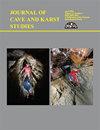Geochemical niches of extremophile communities in an ephemeral acid rock drainage
IF 0.5
4区 地球科学
Q4 GEOSCIENCES, MULTIDISCIPLINARY
引用次数: 0
Abstract
Acid rock drainage (ARD) occurs when metal sulfide minerals are exposed to surface conditions and begin to oxidize. This creates high concentrations of dissolved iron, other metals, and sulfuric acid, creating orange streams, seeps, and pools. These acidic, metal-rich sites host diverse microbial communities that includes extremophilic iron and sulfur oxidizers that take advantage of the abundant chemical energy from sulfide minerals and dissolved iron, and have adapted to extreme acidity and high metal concentrations. The Copper Flat mine is a historic copper mine located in the Hillsboro mining district in south-central New Mexico. It is a low-grade porphyry deposit where the primary copper mineralization is in the form of chalcopyrite veinlets. The mine operated at full production for 3 months in 1982, and was then placed on a care and maintenance plan to await an increase in the market price of copper, but was eventually decommissioned in the 1990s. At this site, there are two extremely acidic seeps that run only once or twice per year for no more than several weeks at a time, depending on monsoon precipitation. Year after year, a vibrant microbial community springs up when these seeps are actively running. However, we know little about the microorganisms that colonize these seeps, and how the ecology, biogeochemistry, and fate and transport of metals change during these seasonal wetting and drying cycles. Here we present preliminary data the microbial communities present in one of the seeps that was running in June 2020. pH and specific conductivity of the seep varied from 1.54-1.95 and 9.01-6.32 mS/cm, respectively. Based on rRNA gene libraries from nine exploratory samples, seep sediments were dominated by populations related to known lithotrophic iron-and sulfur-oxidizing bacteria, acidophilic organoheterotrophs, diverse algae, and novel Proteobacteria and Thermoplasmatales-group Archaea that varied with the pH and salinity gradients in the seep. Bacteria and archaea related to Leptospirillum, Acidiphilum, Acidibacter, Ferrithrix, Cuniculiplasma , and Ferrimicrobium were consistently more abundant at the more acidic site, while Acidicapsa, Acidobacterium , and Alicyclobacillus dominated at the less acidic location. We hypothesize that these differences in community composition are due to differences in pH and metal content of the waste stream, which may represent the tolerances for each population with respect to their preferred geochemical niches in these ephemeral seeps. Future work aimed at understanding the ecological and geochemical constraints on these organisms can help us to better design passive remediation strategies and understand elemental cycling in ARD environments.短期酸性岩石排水中极端微生物群落的地球化学生态位
当金属硫化物矿物暴露在地表条件下并开始氧化时,就会发生酸性岩石排水(ARD)。这会产生高浓度的溶解铁、其他金属和硫酸,形成橙色的溪流、渗漏和水池。这些酸性、富含金属的地点拥有多种微生物群落,包括嗜极铁和硫氧化剂,它们利用硫化物矿物和溶解铁的丰富化学能,并适应极端酸性和高浓度金属。铜平矿是一个历史悠久的铜矿,位于新墨西哥州中南部的希尔斯伯勒矿区。属低品位斑岩矿床,原生铜矿以黄铜矿细脉形式成矿。该矿在1982年全面生产了3个月,然后被置于维护和维护计划中,等待铜的市场价格上涨,但最终在20世纪90年代退役。在这个地方,有两个极酸的渗漏,每年只发生一次或两次,每次不超过几周,取决于季风降水。年复一年,当这些渗漏活跃时,一个充满活力的微生物群落就会涌现出来。然而,我们对这些渗漏的微生物知之甚少,也不知道在这些季节性的干湿循环中,生态、生物地球化学、金属的命运和运输是如何变化的。在这里,我们提供了2020年6月发生的一次渗漏中存在的微生物群落的初步数据。渗液的pH值为1.54 ~ 1.95,比电导率为9.01 ~ 6.32 mS/cm。根据9个探测样本的rRNA基因库,沉积物中主要是已知的岩石营养铁和硫氧化细菌、嗜酸有机异养菌、多种藻类、新型变形菌和热质体古菌群,它们随着沉积物的pH和盐度梯度而变化。与钩端螺旋体、嗜酸菌、嗜酸菌、铁菌、弓形菌和铁微生物相关的细菌和古细菌在酸性较强的地方数量较多,而在酸性较弱的地方,酸性细菌、酸杆菌和艾丽环杆菌占主导地位。我们假设这些群落组成的差异是由于废物流的pH值和金属含量的差异,这可能代表了每个种群在这些短暂渗漏中相对于其首选的地球化学生态位的耐受性。未来的工作旨在了解这些生物的生态和地球化学限制,可以帮助我们更好地设计被动修复策略,并了解ARD环境中的元素循环。
本文章由计算机程序翻译,如有差异,请以英文原文为准。
求助全文
约1分钟内获得全文
求助全文
来源期刊

Journal of Cave and Karst Studies
地学-地球科学综合
CiteScore
1.90
自引率
0.00%
发文量
6
审稿时长
>12 weeks
期刊介绍:
The Journal of Cave and Karst Studies is a multidisciplinary journal devoted to cave and karst research. The Journal is seeking original, unpublished manuscripts concerning the scientific study of caves or other karst features. Authors do not need to be members of the National Speleological Society, but preference is given to manuscripts of importance to North American speleology.
 求助内容:
求助内容: 应助结果提醒方式:
应助结果提醒方式:


